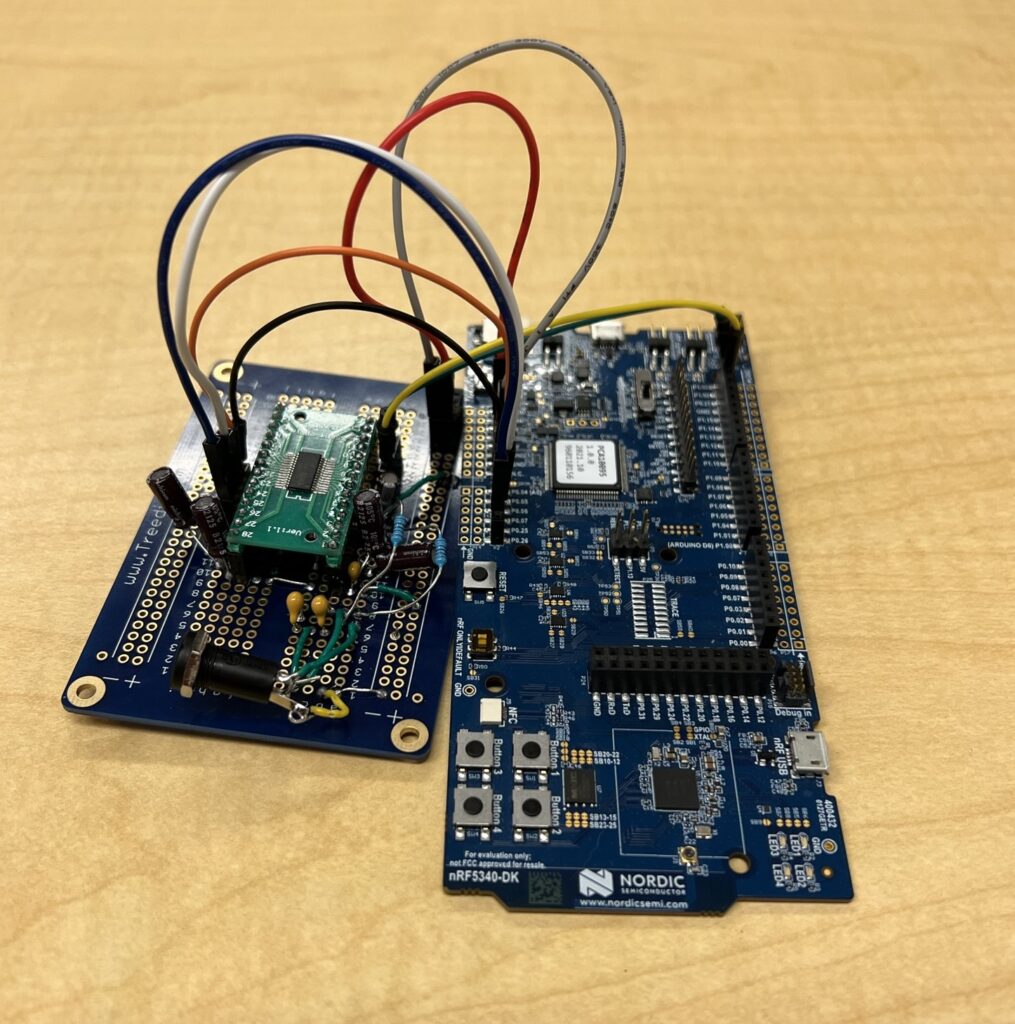Project Category: Software
About our project
All wireless audio products sold today use Bluetooth Classic (BTC) as the streaming protocol. BTC is a 20 year old technology, and offers poor battery performance and technical features compared to its younger sibling Bluetooth Low Energy (BLE); though it does offer a higher bitrate, making previously the only option for audio streaming. However, LE Audio was announced in 2020, which allows audio to be streamed over BLE by using a new, very efficient, audio codec (LC3). This makes BLE a viable lower energy candidate for wireless audio products. Furthermore, using the newer BLE architecture allows interesting new features such as audio broadcasting, making LE audio more flexible in how it can deal with streaming to multiple peripherals. The biggest advantage that BLE has is the lower amount of energy it uses, which translates into more battery life.
Lightning audio is an implementation of LE audio. We have created an audio peripheral which functions like the current bluetooth commercial products on the surface, but uses the Bluetooth Low Energy protocol instead of Bluetooth Classic. Because it is made with the new protocol, it has some very important benefits over the many consumer products on the market today. Specifically, we can play audio at lower bitrates, and we can broadcast audio streams. The lower bitrates are possible thanks to the new LC3 audio codec. Previous bluetooth codecs could not encode effectively enough for low-bitrate audio streams, meaning that acceptable audio quality could not be achieved with this little amount of bandwidth. Audio broadcasting allows any number of BLE devices to listen to an audio source over bluetooth, which isn’t possible using BTC.
Meet our team members
Jedediah Heal

Software Engineer, Project Manager
Jedediah is a Software Engineering student at the University of Calgary. He interned at the groups Sponsor company Garmin, and worked on the BLE software in Garmin products.
Tyler Munro

Hardware Engineer
Tyler is an electrical engineering student at the University of Calgary. He has experience in PCB design, integrated circuit design and embedded systems. Skills in programming languages such as C, Python, Java and VHDL.
Cloud Chagnon

Software Engineer
Cloud is a software engineering student at the University of Calgary, with experience in software audio encoders and decoders. He has skills in programming with Java, C, C++, and Python, with an interest in music and audio production.
Zelong Zhang

Software Engineer
Kevin is a computer engineering student with experience in embedded software development and testing. Relevant skills and experiences to this project include proficiencies in languages C and Python, network programming, and previous work with other embedded projects.
Ethan Schafers

Software Engineer
Ethan is a software engineering student with employment experience in C and embedded systems. Recently he worked at Garmin for his engineering internship, where he worked on the team in charge of power meter bike pedals. In addition to working on the embedded system itself, he developed and maintained development and testing tools for the project.
Riley Martel

Hardware Engineer
Riley is an electrical engineering student at the University of Calgary. He has undertaken several personal engineering projects ranging from: Hifi Amplifier for stereo system, Arduino based MIDI controller/synthesizer, Computer fan attenuation system, and many more. Riley has knowledge in both software ranging from C, C++, Java, Assembly and hardware. He has an interest in the development of music and audio related hardware.
Details about our design
HOW OUR DESIGN ADDRESSES PRACTICAL ISSUES
As the name implies, Bluetooth Low Energy is an alternative to Bluetooth Classic which consumes less power. With recent developments to have audio streaming available via BLE, this means that audio streaming now has an alternative protocol that can lead to longer battery life. This is done through the LC3 audio codec, which allows for audio to be transmitted at a much lower bitrate than Bluetooth Classic, with minimal loss in quality. Since there is less data which is needed to be received and processed, the processor needs to do less, leading to power savings.
Audio broadcasting simplifies the use case of sending an audio stream to multiple devices. In Bluetooth Classic, getting this functionality requires support from the peripheral itself. For instance, a pair of earbuds would require one of the earbuds to be the “master” earbud, and have that earbuds relay the audio stream to the other. This adds power usage and software complexity, which can lead to buggy behaviour. If there is a system of speakers using different BTC connections, it could be improved with audio broadcasting. If all peripherals are listening to the same source, as opposed to duplicated sources, the audio will always be in sync. In BLE, all peripherals can listen to the same audio broadcast without any special relay implementation necessary, eliminating all of this additional complexity.
WHAT MAKES OUR DESIGN INNOVATIVE
While Bluetooth Low Energy has been around for a while, it has not been able to be used for high quality audio transmission until very recently. Because of this, every consumer audio peripheral currently on the market is still using Bluetooth Classic.
Lightning Audio will likely be the first time the capstone fair attendees will encounter audio being streamed from Bluetooth Low Energy.
WHAT MAKES OUR DESIGN SOLUTION EFFECTIVE
Lighting Audio is able to demonstrate the benefits of LE audio in how it improves on Bluetooth Classic, and in what new features it brings.
Results from our audio testing has shown us that our LE Audio stream requires a far smaller bit rate of a Bluetooth Classic stream in order to get a level of quality indistinguishable from an AUX output through mid-range headphones.
We can also use any number of our peripherals to receive audio from a broadcasting source with no delays, synchronization problems, or loss in quality.
HOW WE VALIDATED OUR DESIGN SOLUTION
Validating the quality of audio quantitatively and objectively isn’t feasible, since audio quality itself is so subjective. We validated the quality of the LE audio stream using a subjective audio quality testing method called MUSHRA (MUltiple Stimuli with Hidden Reference and Anchor). Essentially, MUSHRA tests involve listening to different audio tracks (bass-heavy music, treble-heavy music, podcasts, etc.) by using different audio codecs.
In our tests we tested the following audio codecs using a pair of Steelseries Arctis 3 headphones (mid-range headphones):
- 3.5mm AUX cable audio (Reference)
- SBC @ 384+ kbps (Bluetooth Classic)
- LC3 @ 192 kbps (BLE)
- LC3 @ 96 kbps (BLE)
- LC3 @ 48 kbps (BLE)
During our testing, the reference audio, the Bluetooth classic audio, and the 192 kbps BLE audio were found to be basically indistinguishable from each other for all audio samples. There was a noticeable drop in quality at 96 kbps, and the 48 kbps stream was deemed very low quality.
FEASIBILITY OF OUR DESIGN SOLUTION
The operating system used by Lightning Audio is Zephyr RTOS. This is an open-source real-time operating system used for embedded devices. Zephyr supports BLE, so we used the Zephyr libraries for low-level Bluetooth functionality.
The processor used is the nrf5340 from Nordic Semiconductors, which a low-power processor with BLE support, made for embedded devices. We used the nrf5340 development kit, as its I/O allows for effective debugging and testing.
All hardware used by the Lightning Audio peripherals was available “off the shelf”.
Partners and mentors
We would like to thank our academic advisor and our sponsor representatives, who gave the advice and the resources necessary to bring this project to fruition.
Academic Advisor
Leo Belostotski

Sponsor Representatives
Shane Gallup and Patrick Settle

Our photo gallery

The left board contains the DAC, which converts digital data to analogue data, and an 3.5mm aux connector, allowing a pair of headphones or a speaker to be plugged into it.
The right board contains the processor, which receives and processes the data gotten from the Bluetooth stream. It also has buttons used for functionality such as volume control.
These are the same boards as above, with headphones connected to the aux port on the left board, and with a battery connected to the right board.


These are the results from our audio quality listening tests. Listeners were given a set of audio clips for each codec, and were asked to score the quality of each out of five. The plotted scores are the total mean of all scores for each codec.
